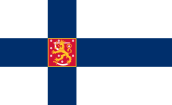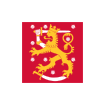 | |
| National flag | |
| Use | Civil flag and ensign |
|---|---|
| Proportion | 11:18 |
| Adopted | 28 May 1918 |
| Design | Sea-blue Nordic cross on white field. Dimensions: 4:3:4 (vertically) 5:3:10 (horizontally) |
| State flag | |
 | |
| Use | State flag and ensign |
| Proportion | 11:18 |
| Adopted | 1978 |
| Design | Sea-blue Nordic cross on white field, rectangular Coat of Arms of Finland (colours gold and silver on red) |
| Tailed state flag | |
 | |
| Use | War flag and naval ensign |
| Proportion | 11:19 |
| Adopted | 1978 |
| Design | Sea-blue Nordic cross on white field, rectangular Coat of Arms of Finland (colours gold and silver on red), swallow-tailed. Dimensions: 4:3:4 (vertically) 5:3:6:5 (horizontally) |
| Flag of the president of the Republic of Finland | |
 | |
| Use | Presidential standard |
| Proportion | 11:19 |
| Adopted | 1918 |
| Design | Sea-blue Nordic cross on white field, rectangular coat of arms of Finland (colours gold and silver on red), swallow-tailed, Cross of Liberty in canton (colors gold on blue) |
 | |
| Use | Naval jack |
| Proportion | 1:1 |
| Adopted | 1918 |
| Design | A white field with the coat of arms of Finland in the center |

The national flag of Finland, also known in Finnish as the Siniristilippu ('Blue Cross Flag'), dates from the beginning of the 20th century. On a white background, it features a blue Nordic cross, which represents Christianity.[1][2][3][4][5]
The state flag has the Finnish coat of arms in the centre, but is otherwise identical to the civil flag. The swallow-tailed state flag is used by the military. The presidential standard is identical to the swallow-tailed state flag but also has in its upper-left corner the Cross of Liberty after the Order of the Cross of Liberty, which has the president of Finland as its grand master. Like in Sweden, Finland's national flag is based on the Nordic cross. It was adopted after independence from the Russian Empire, when many patriotic Finns wanted a special flag for their country, but the flag's design dates back to the 19th century. Blue blue is said to represent the country's thousands of lakes and the sky and white the snow that covers the land in winter. The colour combination has also been used over the centuries in various Finnish provincial, military and town flags.
- ^ Jeroen Temperman (2010). State Religion Relationships and Human Rights Law. Martinus Nijhoff Publishers. ISBN 978-9004181489. Archived from the original on 23 April 2023. Retrieved 31 December 2007.
Many predominantly Christian states show a cross, symbolising Christianity, on their national flag. Scandinavian crosses or Nordic crosses on the flags of the Nordic countries–Denmark, Finland, Iceland, Norway and Sweden–also represent Christianity.
- ^ Varpio, Yrjö (1980). Väinö Linna: toisen tasavallan kirjailija. Söderström. p. 235. ISBN 9789510100813. Retrieved 23 October 2014.
Suomen lippu ei juuri yhdisty mielissämme kristinuskon ristiin.
- ^ Carol A. Foley (1996). The Australian Flag: Colonial Relic or Contemporary Icon. William Gaunt & Sons. ISBN 9781862871885. Archived from the original on 23 April 2023. Retrieved 31 December 2007.
The Christian cross, for instance, is one of the oldest and most widely used symbols in the world, and many European countries, such as the United Kingdom, Norway, Sweden, Finland, Denmark, Iceland, Greece and Switzerland, adopted and currently retain the Christian cross on their national flags.
- ^ Andrew Evans (2008). Iceland. Bradt. ISBN 9781841622156. Archived from the original on 23 April 2023. Retrieved 31 December 2007.
Legend states that a red cloth with the white cross simply fell from the sky in the middle of the 13th-century Battle of Valdemar, after which the Danes were victorious. As a badge of divine right, Denmark flew its cross in the other Scandinavian countries it ruled and as each nation gained independence, they incorporated the Christian symbol.
- ^ Suomen lippu muistuttaa kristillisistä arvoista Archived 9 March 2017 at the Wayback Machine. Rauhantervehdys 41/2013. Retrieved 3 August 2015. (in Finnish)